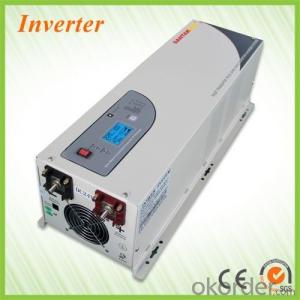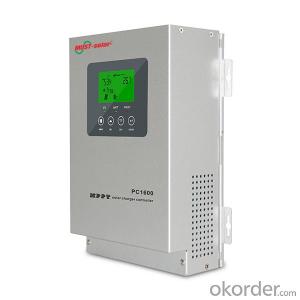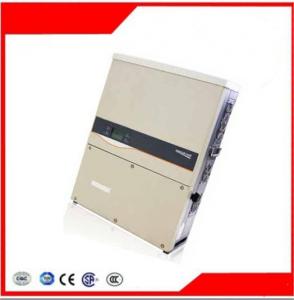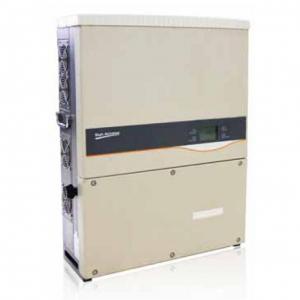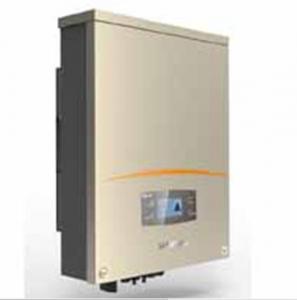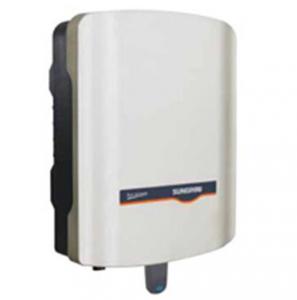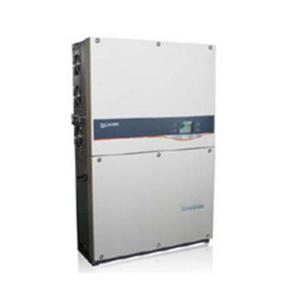Sma Solar Inverter Photovoltaic Grid-Connected Inverter SG4KTL-S
- Loading Port:
- China Main Port
- Payment Terms:
- TT or LC
- Min Order Qty:
- 50000 unit
- Supply Capability:
- 3000000 unit/month
OKorder Service Pledge
OKorder Financial Service
You Might Also Like
1. Structure of Photovoltaic Grid-Connected Inverter SG4KTL-S Description
A solar inverter, or PV inverter, or Solar converter, converts the variable direct current (DC) output of a photovoltaic (PV) solar panel into
autility frequency alternating current (AC) that can be fed into a commercial electrical grid or used by a local, off-grid electrical network.
It is acritical BOS–component in a photovoltaic system, allowing the use of ordinary AC-powered equipment. Solar inverters have
special functions adapted for use with photovoltaic arrays, including maximum power point tracking and anti-islanding protection.
Suitable for 50Hz/60Hz grid, could be used in Asia, Africa and Europe. Available for hand installation, no need for lifting machinery
assistance.
2. Main Features of the Photovoltaic Grid-Connected Inverter SG4KTL-S
• Max. input voltage 600V, compatible with different PV panel and string design
• Only 9kg, easy for handling and installation
• Max. Efficiency at 98.0%
• Ultra-quiet, suitable for residential use
• Access to home WiFi system, easy to enjoy the online monitoring
• Wireless communication design, intelligent mobile phone local and remote monitoring
• Product certification: TÜV, CE, AS4777, AS/NZS 3100, VDE AR N 4105
• Manufacturer certification: ISO 9001, ISO 14001, OHSAS 18000
3. Photovoltaic Grid-Connected Inverter SG4KTL-S Images
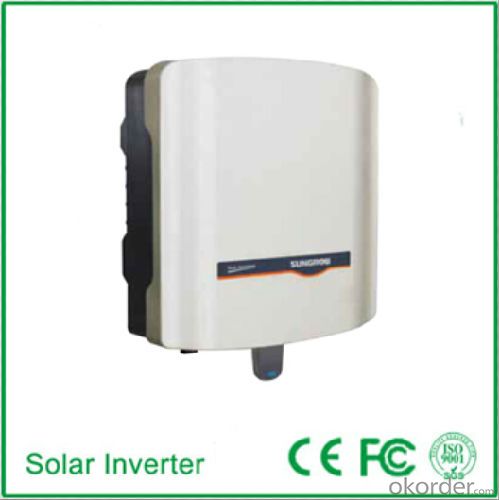
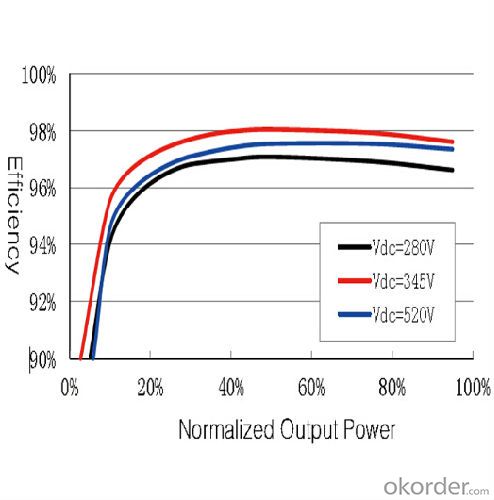
4. Photovoltaic Grid-Connected Inverter SG4KTL-S Specification
Input Side Data | |
| Max. PV input power | 4300W |
| Max. PV input voltage | 600V |
| Startup voltage | 150V |
| Nominal input voltage | 345V |
| MPP voltage range | 125~560V |
| MPP voltage range for nominal power | 240~520V |
| No. of MPPTs | 1 |
| Max. number of PV strings per MPPT | 2 |
| Max. PV input current | 18A |
| Max. current for input connector | 20A |
| Output Side Data | |
| Nominal AC output power | 4000W |
| Max AC output power(PF=1) | 4210W |
| Max. AC output apparent power | 4210VA |
| Max. AC output current | 18.3A |
| Nominal AC voltage | 230Vac (Single phase) |
| AC voltage range | 180~276Vac (May vary as per corresponding country’s grid standard) |
| Nominal grid frequency | 50Hz/60Hz |
| Grid frequency range | 45~55Hz/55~65Hz (May vary as per corresponding country’s grid standard) |
| THD | < 3 % (Nominal power) |
| DC current injection | <0.5 %In |
| Power factor | >0.99@default value at nominal power, (adj. 0.8 overexited~0.8 underexcited) |
| Protection | |
| Anti-islanding protection | YES |
| LVRT | NO |
| DC reverse connection protection | YES |
| AC short circuit protection | YES |
| Leakage current protection | YES |
| DC switch | Optional |
| DC fuse | NO |
| Overvoltage protection | Varistors |
| System Data | |
| Max. efficiency | 98.00% |
| Max. European efficiency | 97.50% |
| Isolation method | Transformerless |
| Ingress protection rating | IP65 |
| Night power consumption | <1W |
| Operating ambient temperature range | -25~60℃ (>45℃ derating) |
| Allowable relative humidity range | 0~100% |
| Cooling method | Natural cooling |
| Max. operating altitude | 4000m (>2000m derating) |
| Display | LED, LCD(optional) |
| Communication | WiFi (optional) |
| DC connection type | MC4 |
| AC connection type | Plug and play connector |
| Certification | IEC61000-6-2,IEC61000-6-3, |
| AS/NZS3100,AS4777.2,AS4777.3 | |
| VDE-AR-N-4105, VDE0126-1-1,CE,G83/2,C10/11,EN50438,CGC | |
| Mechanical Data | |
| Dimensions(W×H×D) | 300*370*125 mm |
| Mounting method | Wall bracket |
| Weight | 9kg |
5. FAQ of Photovoltaic Grid-Connected Inverter SG4KTL-S
Q1:Which payment terms can you accept?
A1:T/T,L/C,Moneygram,Paypal are available for us.
Q2:Can we visit your factory?
A2:Sure,welcome at any time,seeing is believing.
- Q: Are there any noise or sound considerations with a solar inverter?
- Yes, there are noise considerations with a solar inverter. While solar inverters typically produce low levels of noise, it is important to ensure that the inverter is placed in a well-ventilated area to avoid any potential fan or cooling system noise. Additionally, some older models of inverters may produce a slight humming sound during operation, although newer models have significantly reduced this noise.
- Q: How does a solar inverter handle grid faults or disturbances?
- A solar inverter handles grid faults or disturbances by continuously monitoring the grid voltage and frequency. When a fault or disturbance is detected, the solar inverter quickly disconnects from the grid to ensure safety and protect the system. It then enters a standby mode until the grid returns to normal conditions. Once the grid stabilizes, the solar inverter reconnects and resumes its normal operation of converting solar energy into usable electricity.
- Q: What are the potential risks of overloading a solar inverter?
- Overloading a solar inverter can lead to several potential risks. Firstly, it can cause the inverter to overheat, which can result in damage to the internal components and reduce its lifespan. Secondly, overloading can cause the inverter to shut down or trip, interrupting the solar power generation and potentially causing a power outage. Additionally, overloading the inverter may also compromise the safety of the electrical system, increasing the risk of electrical fires or other hazards. Therefore, it is important to ensure that the solar inverter is properly sized and not overloaded to avoid these potential risks.
- Q: How is the efficiency of a solar inverter measured?
- The efficiency of a solar inverter is typically measured by dividing the output power of the inverter by the input power, and then multiplying the result by 100 to get a percentage value.
- Q: Can a solar inverter be used with a solar-powered swimming pool heater?
- Yes, a solar inverter can be used with a solar-powered swimming pool heater. A solar inverter is responsible for converting the direct current (DC) energy produced by solar panels into alternating current (AC) energy that can be used to power appliances and devices. In the case of a solar-powered swimming pool heater, the solar panels generate DC energy from sunlight, which is then converted into AC energy by the solar inverter. This AC energy can be used to power the swimming pool heater and heat the pool water using solar energy.
- Q: How does a solar inverter handle low light conditions?
- A solar inverter handles low light conditions by continuously monitoring the amount of sunlight received by the solar panels. When light levels drop, the inverter adjusts its operation to maximize power output by optimizing the voltage and current levels. It uses advanced algorithms and power electronics to convert the available sunlight into usable electricity efficiently, ensuring that even in low light conditions, the solar system continues to generate power.
- Q: Can a solar inverter be used without solar panels?
- No, a solar inverter cannot be used without solar panels. Solar inverters are designed to convert the direct current (DC) electricity generated by solar panels into usable alternating current (AC) electricity for use in homes or businesses. Without solar panels generating electricity, there is no input for the inverter to convert, rendering it useless.
- Q: Can a solar inverter be used in three-phase systems?
- Yes, a solar inverter can be used in three-phase systems. Three-phase systems are commonly used in industrial and commercial applications, and solar inverters are available in both single-phase and three-phase configurations to accommodate these systems. The three-phase solar inverter converts the direct current (DC) generated by the solar panels into alternating current (AC) that is compatible with the three-phase power grid.
- Q: How do you calculate the maximum power point tracking range for a solar inverter?
- To calculate the maximum power point tracking (MPPT) range for a solar inverter, you need to consider various factors such as the solar panel's voltage and current characteristics, temperature, and the inverter's efficiency. Using the voltage-current (V-I) curve of the solar panel, the MPPT range can be determined by finding the point where the power output is maximized. This is typically done using algorithms within the solar inverter to continuously adjust the operating point to track the maximum power available from the solar panel.
- Q: Can a solar inverter be used in extreme weather conditions?
- Yes, solar inverters are designed to withstand extreme weather conditions. They are built to be durable and resistant to factors such as temperature fluctuations, humidity, and harsh weather elements. However, it is always recommended to consult the manufacturer's guidelines to ensure proper installation and protection measures are in place for specific weather conditions.
Send your message to us
Sma Solar Inverter Photovoltaic Grid-Connected Inverter SG4KTL-S
- Loading Port:
- China Main Port
- Payment Terms:
- TT or LC
- Min Order Qty:
- 50000 unit
- Supply Capability:
- 3000000 unit/month
OKorder Service Pledge
OKorder Financial Service
Similar products
Hot products
Hot Searches
Related keywords











